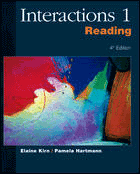 |  Interactions 1 Reading, 4e Elaine Kirn,
West Los Angeles College
Pamela Hartmann,
Los Angeles Unified School District
FeedbackBe happy about errors. They show you the problem areas. Correct answers simply tell you what students already know. Keep reminding students that errors are necessary for progress because they learn how a language works by experimenting and receiving feedback. Students should be working slightly above their ability, so if they aren’t making errors, they are not getting the right amount of challenge.
A. Making Corrections: When and What
As a general rule, errors that interfere with communication are more important than those that don't. Distinguish between error correction in accuracy activities and error correction in fluency activities. Accuracy activities, such as pronunciation drills and cloze exercises, demand that the teacher point out errors. When the objective is fluency, tolerate some errors and note others to be worked on later.
Don't rush correction. First of all, make sure that you are reasonably certain of what the student is trying to say. Then indicate that students have made an error. Give them a chance to correct it if it is reasonable to assume that they will be able to do that. The decision should be made based on the level of the error. If a low-level student makes a present tense error, he/she can reasonably be expected to be able to correct it. However, if the same student makes a passive voice error, you can simply supply the correct form and move on.
B. Making Corrections: How
- Gestures can be used to signal common errors. For example, many teachers point over their shoulders to remind a student that they should be using the past tense.
- Use the board to write clues to help students correct their mistakes. For example, a teacher may put a large S in the corner of the board and simply point to it when students are missing the third person "s."
- If a student has been given time to correct an error and is obviously foundering, simply move on to another student. Do not say, "Can anyone help Ana?" This is very embarrassing to many students. When someone has supplied the answer, go back to the first student and give him/her a chance to give the correct answer.
C. Making Corrections: Peers
- Use pairs for peer correction. Never do it in groups.
- Make sure that students have clear guidelines on what to look for. (For example, look for problems with subject-verb agreement.)
- Have students circle possible errors in pencil. Then the errors can easily be erased if the form actually needs no correction.
- In general, have students point out possible problems rather than fix them yourself.
D. Making Corrections: Whole Class
Class correction is a good way of focusing students' attention on errors made in fluency activities.
- Collect errors from students' written work or notes you have made during fluency activities.
- Write them on a transparency (if you have an overhead projector), type them out and distribute them to the class, or write them on the board. Reword them if necessary to make them anonymous.
- Ask students to correct them as a class or in pairs.
E. The Non-native Speaking Teacher Acting As a Model
Your language may not be perfect, but your students do not speak as well as you do, so they need your class. An important part of language learning is learning to take risks and tolerate imperfection. Your students need to learn to speak freely and without embarrassment. You need to model this attitude.
|
|



 2002 McGraw-Hill Higher Education
2002 McGraw-Hill Higher Education

 2002 McGraw-Hill Higher Education
2002 McGraw-Hill Higher Education